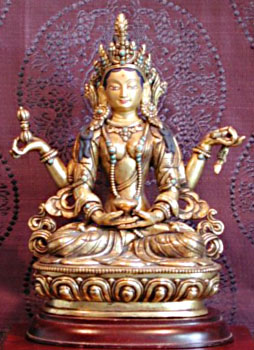 The bipolarity of non-dual reality is expressed in Buddhism through a number of compound terms. In the Buddhist tantras, Sunyata and Karuna are called wisdom and means, prajna and upaya. Prajna is said to be the perfect knowledge of the completeness of all natures, and is passive or static by nature. The active principle is that of karuna, which means compassion, the realization of oneself as being non-different from the other. It serves as the means for the realisation of the highest goal. Prajna commands the metaphysical level while karuna relates to the physical or moral level. Moral actions purified by prajna do not leave vasanas and sarhskaras, and these do not bring about rebirth.
The bipolarity of non-dual reality is expressed in Buddhism through a number of compound terms. In the Buddhist tantras, Sunyata and Karuna are called wisdom and means, prajna and upaya. Prajna is said to be the perfect knowledge of the completeness of all natures, and is passive or static by nature. The active principle is that of karuna, which means compassion, the realization of oneself as being non-different from the other. It serves as the means for the realisation of the highest goal. Prajna commands the metaphysical level while karuna relates to the physical or moral level. Moral actions purified by prajna do not leave vasanas and sarhskaras, and these do not bring about rebirth.
The concepts of prajna and upaya have already been found in a number of previous texts. It has been spoken of by Asvaghosa in the Mahayana-sraddhotpada-sutra. He states in this that Enlightenment has two attributes, pure wisdom (Prajna) and incomprehensible activity (Upaya). Similar references have also been found in the works of Sariputra and Nagarjuna. Northern Buddhism holds that these two aspects of the ultimate reality correspond to vajra-dhatu (tathata) and the Garbhadhatu (tathagatagarbha) respectively. The Prajnika, a sub sect of the Svabhayika school of Nepalese Buddhism equates prajna with Dharma, upaya with the Buddha and the union of the two with Sangha.
In Hevajra Tantra, prajna is understood in two ways- Wisdom (jnanam) and Wisdom consort (mudra). The chief feature of this knowledge is its non-dual nature. It is devoid of the concepts of self and other, space-like, undefiled, void, the essence of existence and non-existence and is supreme. It is known through direct personal experience (svasamvedyam). In Vajrayana, knowledge is the blending of wisdom and means, praj nopayavyatimisrarii, quite unlike the prajna or Sunyata of the Madhyamika. This knowledge is all-pervading (sarvaydai) and abides in all living bodies (sarvadehevyavasthitah). The nature and function of Wisdom (prajna) is indicated by the titles ascribed to it, such as, Mother, Sister, Washerwoman, Daughter, Dancer, and Outcaste Woman. It gives birth to the universe and hence it is called Mother. It
is prajna that distinguishes the Absolute and the relative, and hence is called sister (bhaginsi tathd prajna vibhagam darsayed yatha). Wisdom is called Washerwoman because she delights all beings with great bliss. It is the fullness of enlightened qualities (gunasya duhanat prajna) and hence it is addressed as daughter. Since the novice cannot stabilise this wisdom it is called dancer {prajna cancalatvan). Prajna is called Dombi (outcaste woman) because it is outside the ken of sense experience (indriyanam agocaratvena).
The other notion of prajna lies in its understanding as wisdom consort (mudra/mahdmudra). As wisdom consort she is the personification of wisdom (sa dhiti). She is the noble lady (saiva bhagavat prajna). She is of the nature of
the Five Aspects of Enlightened Awareness (pancajnanasvarupini). She is Nairatmya, the essence of nature and is none other than Hevajra himself.
Thus here again the concept of the dual concept is repeated, and prajna includes the notion of updya as well. This non dual union of the two aspects is called prajnopdya. Wisdom cannot be pursued in isolation. The yogi should take into account all the other sentient beings. Similarly Method when divorced from Wisdom has the effect of chaining the individual to sarhsara. Hevajra Tantra indicates this inseparability of prajna and updya by stating that prajna pervades the world. In the Vajrayanic conception of the Ultimate Reality, the Real is not just sunyata or prajna: but prajnopaya, i.e., the fusion of sunyata and karuna.
Hevajra Tantra does not elaborate on the nature of upaya. In fact in the text itself we find a bias in the favour of prajana. There are only a few references to upaya in our text. It is symbolised sometimes as the corpse on which the yoginis stand or as the hand-drum which is one of the five ornaments of the yogi. The text equates prajna with dharmakaya, while updya is related to the sambhogakaya and nirmanakaya, which originate for the benefit of the world from the Source of Nature (dharmadhatu). Upaya is hence, essentially compassion.
It is said that compassion is born of the realisation of the universality and unity of all beings. Karuna is the earnest desire to save all beings from dukha and the causes of dukha. It is believed to be inseparable from sunyata, as the latter is the reason for the existence of the former. A person can be compassionate only if he overcomes his `species bias` by which he considers the humans as different and superior to the rest. Sunyata enables one to realise that differences are only skin deep.
Vajrayana summarises the entire process of Paramitdyana in the twin principles of prajna and updya. The bodhisattva marga towards samyaksarhbodhi can be reduced to jnanasambhara and punyasambhara. The first is prajnd, which is attained through meditation, and the second is updya achieved through the practice of virtues like dana etc.




















